Northern California Treatment for Sprains & Strains

Introduction
An ankle sprain is a common injury and usually results when the ankle is twisted, or turned in (inverted). The term sprain signifies an injury to the soft tissues, usually the ligaments, of the ankle.
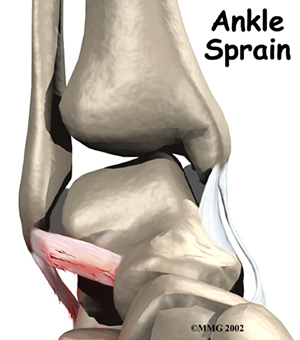
Anatomy
Ligaments are tough bands of tissue that help connect bones together. Three ligaments make up the lateral (outside) ligament complex on the side of the ankle farthest from the other ankle. These include the anterior talofibular ligament (ATFL), the calcaneofibular ligament (CFL), and the posterior talofibular ligament (PTFL). The most common type of ankle injury (inversion) usually involves two ligaments, the ATFL and CFL. Normally, the ATFL keeps the ankle from sliding forward, and the CFL keeps the ankle from rolling inward on its side.
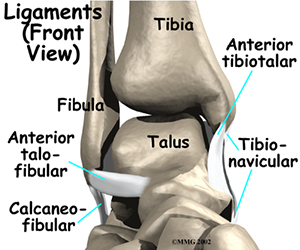
Common Causes of Sprains & Strains
A ligament is made up of multiple strands of connective tissue, similar to a nylon rope. A sprain results in stretching or tearing of the ligaments. Minor sprains only stretch the ligament. A tear may be either a complete tear of all the strands of the ligament or a partial tear of some of the strands. The ligament is weakened by the injury; how much it is weakened depends on the degree of the sprain.
The lateral ligaments are by far the most commonly injured ligaments in a typical inversion injury of the ankle. In an inversion injury the ankle tilts toward the inside, meaning the bottom of the foot tilts inward towards the big toe side of the foot. This forces all the weight of your body onto the outside edge of the ankle. As a result, the ligaments on the outside of the ankle are stretched and possibly torn.
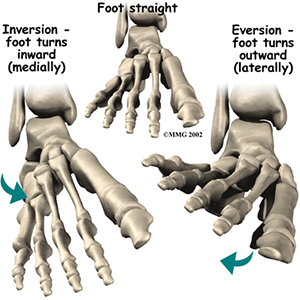
Sprains & strains at a glance:
- Injuries to the ligaments and tendons are known as sprains and strains.
- Sprains (ligament injuries) affect the joints and occur when there is damage or trauma to the tissue that connects two bones.
- Strains (tendon injuries) affect the muscles and are caused by damage or trauma to the fiber that connects muscle to bone.
- Both sprains and strains are ranked by three degrees of severity: slight tear, incomplete or partial tear, and severe tear or rupture.
- Symptoms of these ligament and tendon injuries include pain, swelling, and tenderness. In a sprain, there may also be a feeling of instability in the joint. In a strain, the pain may worsen when the joint is used.
- Initial treatment should include the RICE protocol.
Symptoms of sprains & strains
Sprain symptoms include:
- Pain and stiffness
- Swelling
- Bruising
- Redness and increase in skin temperature
Strain symptoms include:
- Sharp pain
- Difficulty putting weight on the injured limb
- Decreased range of motion of the injured joint
Consult an orthopedic physician if:
- Symptoms do not improve in two to three days
- A popping sound is heard during the injury or when the joint is moved
- It is impossible to move the injured limb or joint
- The bones in the injured joint are misaligned
- It is difficult to walk or move after an injury to the back
- Additional symptoms include numbness, significant swelling, fever, or open wounds
Treatment of Sprains & Strains
Initial treatment for both sprains and strains include the RICE protocol: rest, applying ice, compressing the injured joint or limb with an elastic bandage, and elevating the injured area. Over-the-counter anti-inflammatory medicine like ibuprofen can help reduce the pain and swelling. Physical therapy is also often beneficial for treatment.
In more severe injuries, immobilizing the injured area with a cast or splint may be necessary to allow the limb or joint to rest. Surgery to repair severely torn or damaged ligaments or tendons may be necessary for third-degree injuries, such an ACL tear.
Ankle Instability
If the ankle ligaments do not heal adequately with conservative treatment, you may end up with ankle instability. This can cause the ankle to give way and feel untrustworthy on uneven terrain. If your ankle ligaments do not heal adequately following an ankle sprain, your doctor may suggest several things.
Changes in your footwear may be prescribed to help keep your ankle from turning in. Placing a heel wedge under the outer half of your heel blocks the ankle from rolling, as does a flared heel built into your shoe. In extreme cases, doctors may prescribe a plastic brace, called an orthosis, to firmly hold your ankle from rocking side to side. Some patients feel a sense of steadiness from wearing high-topped shoes. Patients with ankle instability should avoid wearing high-heeled shoes.
Physical therapy treatments will probably be initiated to help restore joint range of motion, strength, and joint stability.
Small nerve sensors inside the ligament are injured when a ligament is stretched or torn. These nerve sensors give your brain information about the position of your joints, a sensation called position sense. For example, nerve sensors in your arm and hand give you the ability to touch your nose when your eyes are closed. The ligaments in the ankle work the same way. They send information to your nervous system to alert you about the position of your ankle joint. A physical therapist will help you retrain this sensation as a way to steady the ankle joint and protect you from spraining your ankle again.
Many people who have ankle instability have weakness in the muscles along the outside of the leg and ankle. These are called the peroneal muscles. Strengthening these muscles may help control the ankle joint and improve joint stability.
Surgery
Doctors will occasionally do surgery right away in athletes who tear a lateral ankle ligament. In most other cases of torn ankle ligaments, doctors will try nonsurgical treatments before doing reconstructive surgery of the ligaments.
Ligament Tightening Procedure
Chronic ankle instability can happen when the lateral ankle ligaments are stretched or torn and the ankle keeps giving way. Surgery can be done to tighten the stretched ligaments and improve the stability of the ankle. The surgery usually involves the ATFL and the CFL.
In this procedure, an incision is made in the skin that lies over the lateral ligaments. Using a scalpel, the surgeon cuts the ATFL and CFL in half.
Holes are drilled along the lower end of the fibula bone, the small bone of the lower leg. The two ends of the cut ligament are overlapped and sewn together. The surgeon uses the drill holes in the fibula to hold the stitches to the bone.
A large band of connective tissue crosses the front of the ankle just below the lateral ligaments. This band, called the ankle retinaculum, holds the tendons in place. The surgeon pulls the top edge of the ankle retinaculum upward and sews it into the fibula. This helps reinforce the reconstructed ligaments.
Tendon Graft Procedure
Another type of reconstruction is done using a tendon graft. If your doctor feels the stretched and scarred ligaments are not strong enough to simply repair in a ligament tightening procedure, then the ligaments must be reinforced with a tendon graft.
In this procedure, the surgeon removes a portion of one of the nearby tendons to use as a tendon graft. The tendon most commonly used attaches the peroneus brevis muscle to the outside edge of the small toe. A section of this tendon is put in place of the torn lateral ligaments.
After making the skin incision, the surgeon drills a hole in the fibula near the attachment of the original ligament. A second drill hole is made in the area where the ligament attaches on the talus (the ankle bone).
The tendon graft is then removed (or “harvested”) and woven between these holes to recreate the ligament complex.
After surgery, you will probably be placed in a cast or brace for about six weeks to allow the tendon reconstruction to heal. Following removal of the cast, physical therapy will be required to regain full use of the ankle.
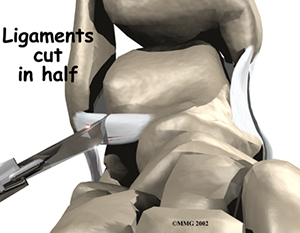
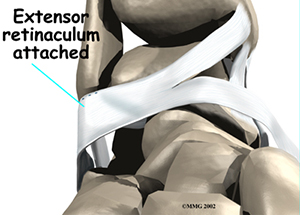
Rehabilitation
Even if you don’t need surgery, you may need to follow a program of rehabilitation exercises. Your doctor may recommend that you work with a physical therapist. Your therapist can create a program to help you regain ankle function. It is important to improve strength and coordination in the ankle.
After surgery, patients usually take part in formal physical therapy. Rehabilitation after surgery can be a slow process. You will probably need to attend therapy sessions for two to three months, and you should expect full recovery to take up to six months.
Rehabilitation proceeds cautiously after reconstruction of the ankle ligaments. Most patients are prescribed an ankle brace to wear when they are up and about, and they are strongly advised to follow the recommendations about how much weight can be borne while standing or walking. You may be instructed to put little or no weight on your foot when standing or walking for up to twelve weeks. Your physical therapist will work with you to make sure you are using crutches safely and only bearing the recommended amount of weight on your foot.
The first few physical therapy treatments are designed to help control pain and swelling from the surgery. Ice and electrical stimulation treatments may be used during your first few therapy sessions to help control pain and swelling. Your therapist may also use massage and other hands-on treatments to ease muscle spasm and pain.
Treatments are also used to help improve ankle range of motion without putting too much strain on the healing ligaments.
After about six weeks you may start doing more active exercise to improve muscle strength. Your therapist will also help you retrain position sense in the ankle joint to improve the stability of the joint.
The physical therapist’s goal is to help patients keep their pain under control, improve range of motion, and maximize strength and control in the ankle. When patients are well underway, regular visits to the therapist’s office will end. The therapist will continue to be a resource, but patients will be in charge of doing their exercises as part of an ongoing home program.
